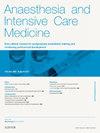Postoperative care and analgesia in vascular surgery
IF 0.3
Q4 ANESTHESIOLOGY
引用次数: 0
Abstract
Patients undergoing major vascular surgery are at high risk for myocardial infarction, renal failure, respiratory complications and death. Invasive procedures confer greater risk of complication, with patients undergoing open aortic surgery being at highest risk. Endovascular procedures are less invasive, yet not devoid of potentially serious complications. Reduction of myocardial oxygen demand is key, as is stabilizing cardiovascular parameters, maintaining normothermia, adequate volume resuscitation and effective analgesia. Continuation of preoperative risk-reduction strategies including aspirin, β-blockers and statin therapies are critical, and should be continued in the postoperative period. Additionally, maintaining a high index of suspicion for procedure-specific complications is essential to reduce morbidity and mortality in these patients.
血管手术的术后护理与镇痛
接受大血管手术的患者发生心肌梗死、肾功能衰竭、呼吸系统并发症和死亡的风险很高。侵入性手术带来更大的并发症风险,接受主动脉开腹手术的患者风险最高。血管内手术侵入性较小,但并非没有潜在的严重并发症。降低心肌需氧量是关键,稳定心血管参数、维持体温正常、充分的容量复苏和有效的镇痛也是关键。术前风险降低策略的延续,包括阿司匹林、β受体阻滞剂和他汀类药物治疗至关重要,并应在术后继续。此外,保持对手术特异性并发症的高度怀疑指数对于降低这些患者的发病率和死亡率至关重要。
本文章由计算机程序翻译,如有差异,请以英文原文为准。
求助全文
约1分钟内获得全文
求助全文
来源期刊

Anaesthesia and Intensive Care Medicine
ANESTHESIOLOGY-
CiteScore
0.50
自引率
0.00%
发文量
152
期刊介绍:
Anaesthesia and Intensive Care Medicine, an invaluable source of up-to-date information, with the curriculum of both the Primary and Final FRCA examinations covered over a three-year cycle. Published monthly this ever-updating text book will be an invaluable source for both trainee and experienced anaesthetists. The enthusiastic editorial board, under the guidance of two eminent and experienced series editors, ensures Anaesthesia and Intensive Care Medicine covers all the key topics in a comprehensive and authoritative manner. Articles now include learning objectives and eash issue features MCQs, facilitating self-directed learning and enabling readers at all levels to test their knowledge. Each issue is divided between basic scientific and clinical sections. The basic science articles include anatomy, physiology, pharmacology, physics and clinical measurement, while the clinical sections cover anaesthetic agents and techniques, assessment and perioperative management. Further sections cover audit, trials, statistics, ethical and legal medicine, and the management of acute and chronic pain.
 求助内容:
求助内容: 应助结果提醒方式:
应助结果提醒方式:


